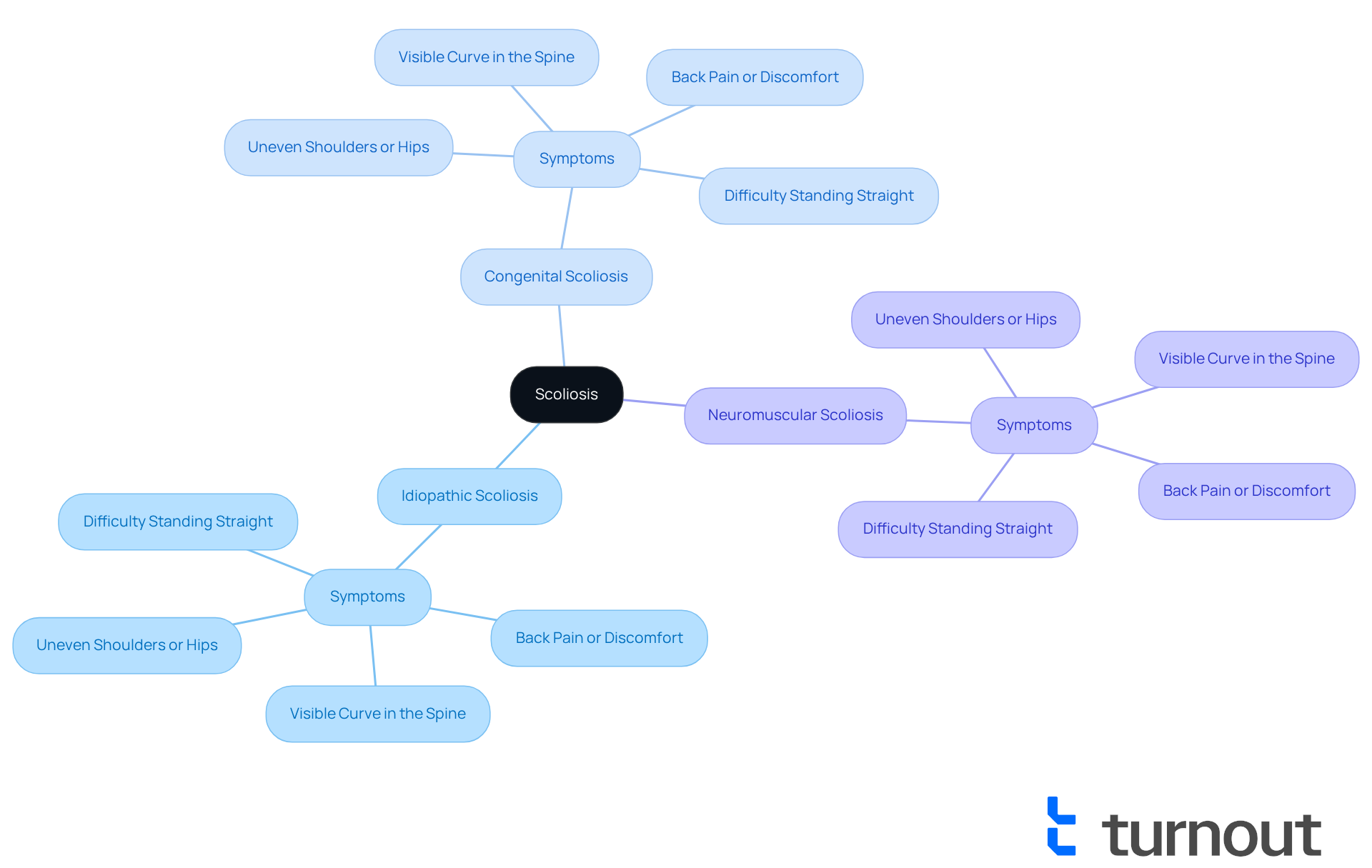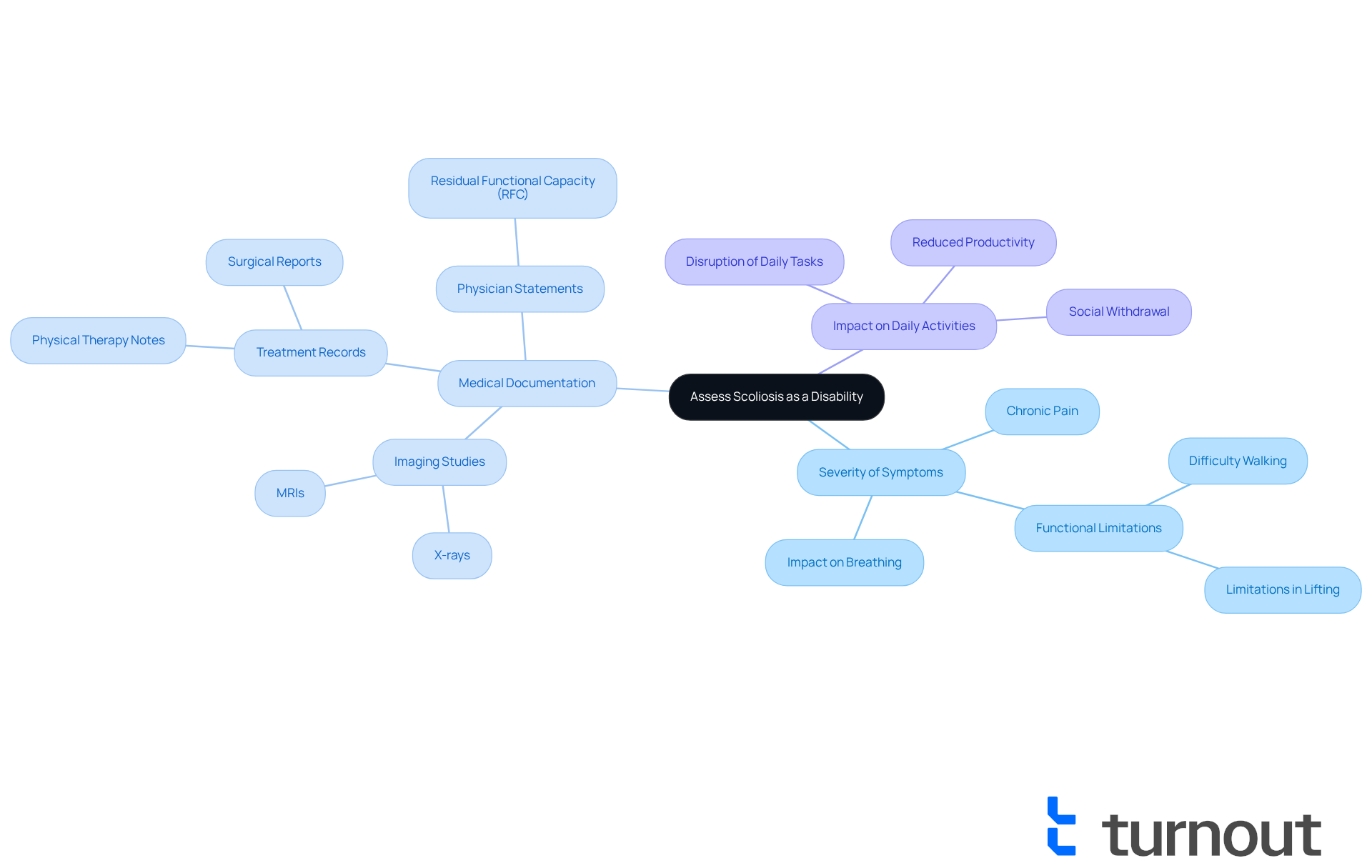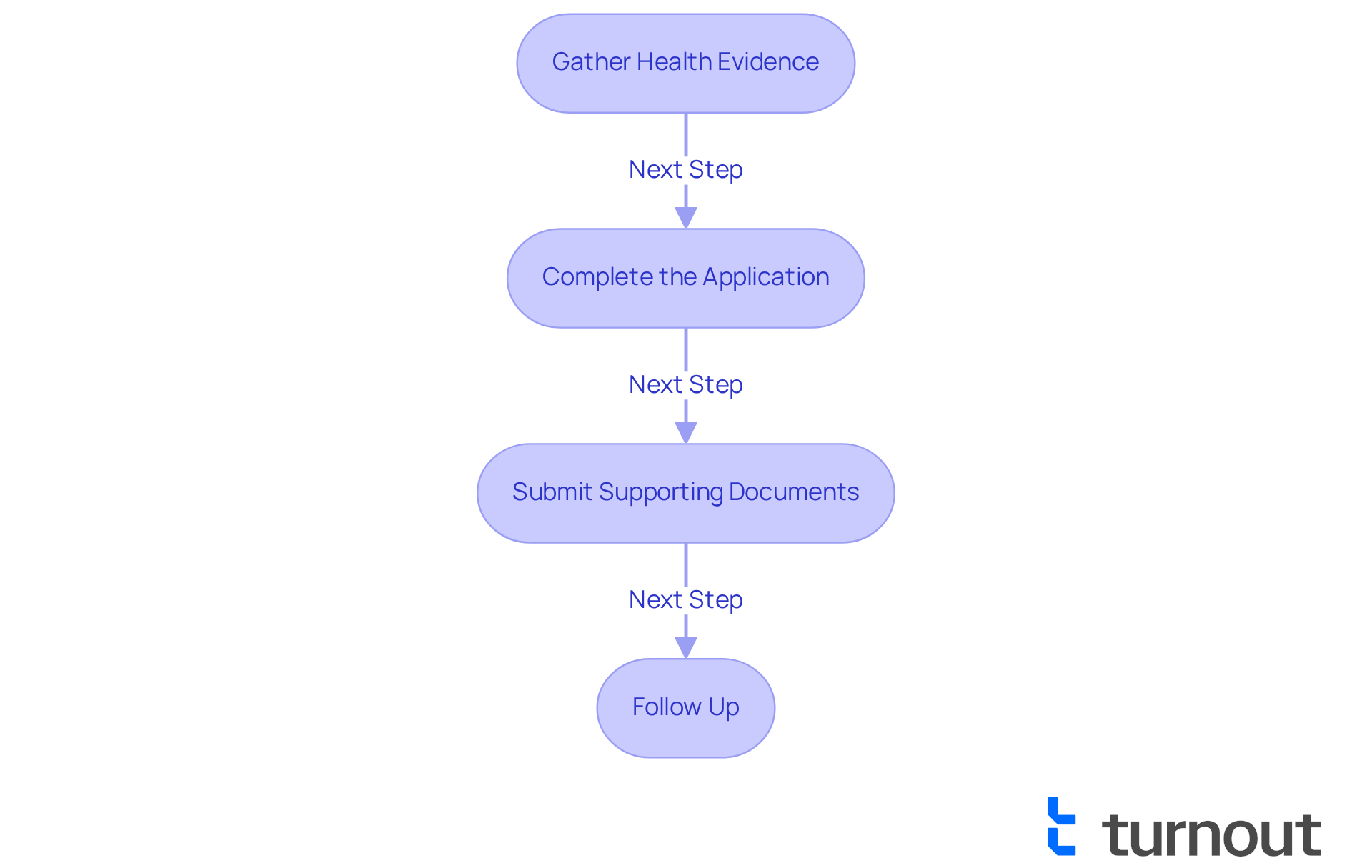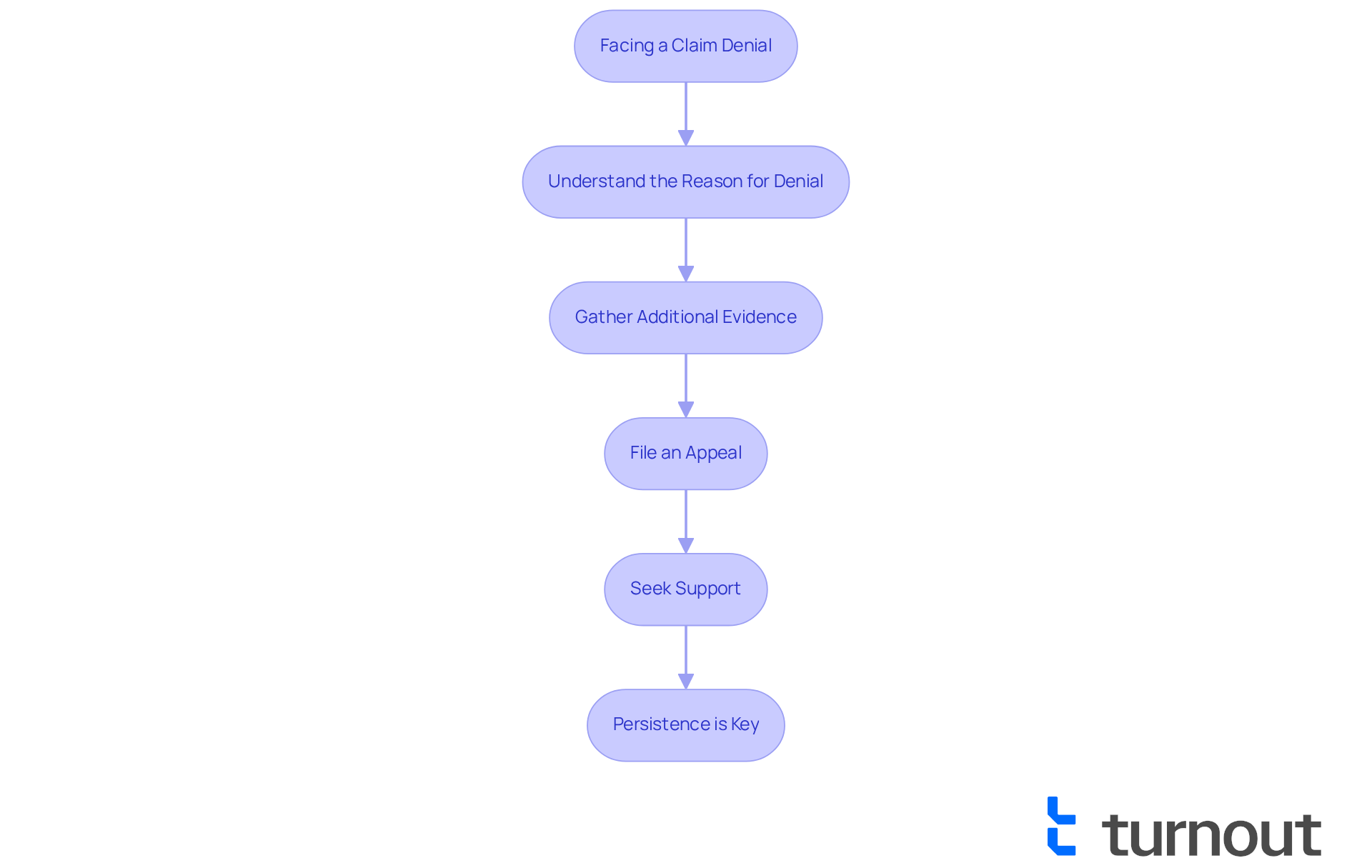Overview
If you or a loved one is facing the challenges of scoliosis, you may be wondering about the possibility of qualifying for disability benefits. It’s important to understand that individuals with this condition can indeed receive support if they can show that scoliosis significantly impacts their ability to work and carry out daily activities.
To qualify, you'll need to provide substantial medical documentation that clearly outlines how scoliosis affects your functional capabilities. This requirement aligns with the criteria set by the Social Security Administration for musculoskeletal disorders. We understand that gathering this information can feel overwhelming, but you are not alone in this journey.
Taking the first step can be daunting, yet it’s essential to realize that there are resources available to help you navigate this process. We’re here to help you through each stage, ensuring that you have the support you need. Remember, you deserve to have your challenges acknowledged and addressed.
Introduction
Scoliosis is an often misunderstood condition, marked by an abnormal curvature of the spine. For many, it can significantly impact daily life and work capabilities. We understand that navigating this challenge can be overwhelming, and for those grappling with scoliosis, understanding the potential for disability benefits is crucial. This guide aims to shed light on the eligibility criteria, application process, and common challenges faced when seeking disability for scoliosis.
You may be wondering: can individuals with scoliosis secure the support they need amidst a complex system? It's common to feel uncertain about the options available. We’re here to help you explore this journey together, providing the information you need to take the next steps with confidence.
Define Scoliosis: Types and Symptoms
Scoliosis is characterized by an abnormal lateral curvature of the spine, which can manifest in various forms. We understand that this condition can be concerning, and it’s important to recognize the different types:
- Idiopathic Scoliosis: The most common type, often diagnosed in adolescents, with no known cause.
- Congenital Scoliosis: Results from a malformation of the spine during fetal development.
- Neuromuscular Scoliosis: Associated with conditions like cerebral palsy or muscular dystrophy.
Symptoms may vary, but often include:
- Uneven shoulders or hips
- A visible curve in the spine
- Back pain or discomfort
- Difficulty standing straight
Recognizing these symptoms is the first step in understanding how scoliosis may impact your daily life and work. This awareness is critical for navigating disability claims, particularly when considering if you can get disability for scoliosis. At Turnout, we’re here to help you through the complexities of Social Security Disability (SSD) claims. Our skilled nonlegal advocates understand your struggles and are dedicated to supporting you in comprehending how your situation may qualify you for benefits, and they can help you answer the question, can you get disability for scoliosis? Early detection and intervention can lead to better outcomes, making timely medical evaluation essential. Remember, you are not alone in this journey; we are here to guide you every step of the way.

Assess Scoliosis as a Disability: Eligibility Criteria
If you are facing challenges due to scoliosis, you may be wondering, can you get disability for scoliosis? To qualify, it's essential to demonstrate that your condition significantly restricts your ability to work. The Social Security Administration (SSA) evaluates claims based on several important factors:
- Severity of Symptoms: It's crucial to provide evidence that scoliosis leads to significant pain or functional limitations, which can hinder your ability to perform work-related tasks.
- Medical Documentation: Comprehensive medical records are vital. This includes imaging studies like X-rays and MRIs, along with detailed evaluations from healthcare providers that outline the severity of your condition.
- Impact on Daily Activities: Evidence should clearly indicate how scoliosis disrupts your daily tasks and overall work abilities, showcasing the extent to which it affects your life.
While scoliosis may not be explicitly listed as a specific impairment in the SSA's guidelines, can you get disability for scoliosis if you meet the functional criteria outlined in the SSA's Blue Book under the broader category of musculoskeletal disorders? This involves demonstrating that your condition significantly limits basic work activities, such as walking, standing, and lifting.
We understand that navigating this process can be overwhelming. Please know that you are not alone in this journey, and we’re here to help you every step of the way.

Navigate the Application Process for Disability Benefits
Navigating the application process for disability benefits can feel overwhelming, but you are not alone in this journey. Here are some essential steps to guide you:
- Gather Health Evidence: Start by collecting all pertinent health records, including your diagnosis, treatment history, and imaging results. Objective clinical evidence, such as X-rays and MRIs, is crucial to illustrate the severity of your situation.
- Complete the Application: You can submit your application online, by phone, or in person at a local SSA office. It's important to fill out every section accurately to avoid any unnecessary delays.
- Submit Supporting Documents: Along with your application, include any additional documentation that supports your claim. This might include detailed statements from healthcare providers explaining how scoliosis impacts your daily life and work capabilities and whether that indicates that you can get disability for scoliosis. Consistent medical treatment records are vital to showcase the severity of your condition.
- Follow Up: After submitting your application, it’s wise to monitor its status. Be prepared to provide further information if the SSA requests it. Consistent follow-ups can help resolve any concerns that might arise during the evaluation phase.
Turnout is here to offer essential support in managing this process. Our trained nonlegal advocates can assist you in navigating SSD applications, ensuring you don't have to go through this alone. It’s important to remember that Turnout is not a law firm and does not provide legal advice. Being meticulous and systematic throughout this procedure can greatly enhance your chances of a successful request.
Statistics suggest that about 65% of initial disability applications are rejected. However, many are granted during the appeals stages. This highlights the importance of thorough documentation and determination. Successful claims often focus on how your condition restricts daily activities and work abilities, leading to the question of can you get disability for scoliosis?. Additionally, staying informed about recent updates to the SSA application process is crucial, as changes could affect your eligibility and benefits. Remember, we’re here to help you every step of the way.

Overcome Challenges: Addressing Claim Denials and Appeals
Facing a claim denial can feel overwhelming, and it’s completely understandable to be disheartened. However, there are effective steps you can take to appeal the decision:
-
Understand the Reason for Denial: Take a moment to carefully review the denial letter. Identifying the specific reasons for rejection is crucial. Common issues often include insufficient health documentation or a failure to demonstrate the severity of your condition.
-
Gather Additional Evidence: If the denial was due to insufficient health records, don’t hesitate to collect further evidence that supports your claim. This may include updated medical evaluations, detailed statements from healthcare providers, and documentation of your symptoms and limitations.
-
File an Appeal: You have the right to request a reconsideration of the decision. This involves a review by a different SSA representative. If denied again, you can advance the matter by requesting a hearing before an Administrative Law Judge (ALJ). It’s encouraging to note that nearly 50% of requests are approved after an ALJ hearing, highlighting the importance of persistence.
-
Seek Support: Consider reaching out to a disability advocate, such as those provided by Turnout. They can offer valuable guidance throughout the appeals process. Turnout employs trained non-professional advocates who are qualified to help you navigate the complexities of SSD processes. However, it's important to remember that Turnout is not a legal practice and does not provide legal guidance. Engaging with experienced professionals can significantly improve your chances of success.
Persistence is key. Many successful claims are approved during the appeal stages, so don’t lose hope. A denial is not the end of your journey; it’s an opportunity to strengthen your case and pursue the benefits you deserve. As David W. Magann wisely states, "A denial letter does not mean your case is over.

Conclusion
Understanding scoliosis, its types, symptoms, and the potential for disability benefits is essential for those affected by this condition. We recognize the complexities of navigating the Social Security Disability (SSD) system. While scoliosis may not be explicitly listed as an impairment, you can still qualify for benefits by demonstrating how your condition limits your daily activities and work capabilities.
Throughout this article, we highlight the importance of thorough medical documentation and the eligibility criteria set by the Social Security Administration. We provide step-by-step guidance for applying for disability benefits. It’s common to face challenges such as claim denials and the appeals process, but remember that persistence and proper support can significantly enhance your chances of a successful claim.
In conclusion, if you are dealing with scoliosis, it’s vital to remain informed and proactive in your pursuit of disability benefits. The journey may be challenging, but with the right resources and support, you can navigate the complexities of the application process and advocate effectively for the benefits you deserve. Taking the first step toward understanding and addressing the impact of scoliosis can lead to a more empowered future. You are not alone in this journey, and we’re here to help.
Frequently Asked Questions
What is scoliosis?
Scoliosis is characterized by an abnormal lateral curvature of the spine, which can manifest in various forms.
What are the different types of scoliosis?
The different types of scoliosis include: - Idiopathic Scoliosis: The most common type, often diagnosed in adolescents, with no known cause. - Congenital Scoliosis: Results from a malformation of the spine during fetal development. - Neuromuscular Scoliosis: Associated with conditions like cerebral palsy or muscular dystrophy.
What are the common symptoms of scoliosis?
Common symptoms of scoliosis may include: - Uneven shoulders or hips - A visible curve in the spine - Back pain or discomfort - Difficulty standing straight
Why is it important to recognize the symptoms of scoliosis?
Recognizing the symptoms is essential for understanding how scoliosis may impact daily life and work, and it is critical for navigating disability claims.
Can you get disability for scoliosis?
Yes, it is possible to qualify for disability benefits for scoliosis, and understanding your situation is important for the claims process.
How can Turnout assist with Social Security Disability claims for scoliosis?
Turnout provides support through skilled nonlegal advocates who help individuals comprehend how their situation may qualify for benefits and navigate the complexities of the Social Security Disability claims process.
Why is early detection and intervention important for scoliosis?
Early detection and intervention can lead to better outcomes, making timely medical evaluation essential for those affected by scoliosis.




